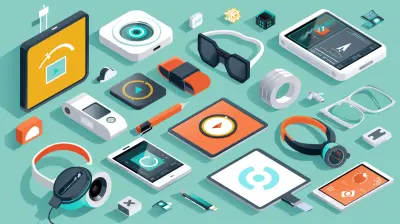How to Measure Student Progress in a Virtual Classroom
10 August 2025
Let’s face it—teaching in a virtual classroom isn't the same as standing in front of a whiteboard with a class full of buzzing students. But just because we can’t see every raised hand or puzzled expression doesn't mean we can't track how well students are doing. In fact, measuring student progress online is just as possible—if not better at times—with the right tools and mindset.
Whether you're a seasoned online instructor or someone who's just transitioned from traditional classrooms, there's always something new to learn about keeping tabs on your students' growth. So grab your favorite mug of coffee (or tea), and let’s dive into some practical, easy-to-follow ways to measure student progress in a virtual classroom.
Why Monitoring Student Progress Matters More Than Ever
When you're teaching online, it’s easy for students to fade into the background. Cameras are off, microphones are muted, and sometimes... it feels like you're speaking into a void. But here’s the thing: just because you can't see them learning doesn’t mean they’re not learning. And just because someone’s “present” online doesn’t mean they’re actually engaged or grasping the material.That’s why it’s crucial to measure progress—not just for grading but to make sure students are on the right track, not silently struggling.
But First—What Do We Mean by “Progress”?
Good question. Progress isn’t just about grades. It includes:- Understanding course concepts
- Applying knowledge in creative ways
- Participating meaningfully in discussions
- Demonstrating improvement over time
In short, progress is about growth—not perfection.
1. Use Frequent Formative Assessments
Think of formative assessments as checkpoints on a journey. They're small “pulse checks” rather than big, scary final exams.Examples of Formative Assessments You Can Use Online:
- Quick quizzes through Google Forms or LMS platforms- One-question polls at the end of a lesson
- Short reflection paragraphs on what they learned
- Exit tickets: a simple “What stuck with you today?” prompt
These low-pressure tools help you see who’s following along and who might need some extra help.
> Tip: Use tools like Kahoot!, Quizizz, or Socrative to make it fun and interactive.
2. Track Participation—But Make It Meaningful
Attendance is one thing. Active participation is another beast entirely. In a virtual classroom, engagement doesn’t always look like raising a hand—it might be posting in chat, sharing a comment in a discussion forum, or collaborating in a breakout room.How You Can Measure Participation:
- Count how often students contribute to discussions (live or through forums)- Look at the quality of their input—are they asking thoughtful questions? Responding to peers?
- Use digital rubrics to provide feedback on discussion contributions
Interaction isn't just about having a voice in the room. It’s about students making connections with the content and each other.
3. Analyze Assignment Submissions Over Time
Online platforms make it super easy to track student submissions and their performance trends.What You Should Be Looking For:
- Are students improving in how they structure their responses?- Is their critical thinking becoming sharper?
- Are they applying feedback from previous assignments?
Spotting these patterns early helps you support students before they fall too far behind. Also, you can tailor your teaching better when you know what topics trip them up.
> Think of this like reading a story. Each assignment is a new chapter in a student's learning journey.
4. Use Digital Portfolios to Showcase Growth
Digital portfolios are like virtual time capsules. You can see how students evolve over a semester—what skills they’ve picked up, what ideas they’ve explored, and how their confidence has grown.What to Include in a Digital Portfolio:
- Reflective journals- Major projects
- Peer reviews
- Self-assessments
Tools like Seesaw, Google Sites, or Padlet make portfolio-building a breeze. Plus, students love seeing how far they’ve come—it builds confidence like nothing else.
5. Include Self-Assessments and Peer Reviews
Learning isn’t a one-way street. Students must be part of the process, not just passive recipients. Having them reflect on their own work or review a peer’s submission brings a whole new layer of awareness.Why This Works:
- It encourages metacognition (thinking about thinking)- Students start to recognize their own gaps
- Peer feedback fosters a collaborative learning culture
Bonus: Self-assessment rubrics can be easily shared in Google Classroom or any LMS.
6. Use Learning Analytics to Spot Trends
This is where technology really shines. Most virtual classrooms come with built-in analytics that track everything—from how long it takes to complete an assignment to how many times a student logs in.Analytics You Should Keep an Eye On:
- Time on task- Frequency of login/activity
- Completion rates for assignments
- Test and quiz scores over time
If someone’s engagement drops, it’s usually the first sign they need extra support. Use those digital breadcrumbs to guide your next steps.
7. Set SMART Goals with Your Students
Have you heard of SMART goals? They’re Specific, Measurable, Achievable, Relevant, and Time-bound. Helping students set these kinds of goals makes progress visible—and motivating.Example of a SMART Goal:
“I want to improve my quiz scores from 70% to 85% over the next three weeks by reviewing one chapter per day.”Let students track their own goals in shared Google Docs or a personal progress tracker. When they hit their goals, celebrate it!
8. Provide Regular, Personalized Feedback
In a virtual classroom, feedback is your superpower. It bridges the gap between you and your students. But the key is making it timely, actionable, and kind.Make Feedback Count:
- Focus on what they did well, not just what went wrong- Be clear and specific
- Offer suggestions for improvement
A voice note or short recorded video can make it feel more personal and less robotic.
9. Mix in Project-Based Learning
Projects give students the freedom to apply what they’ve learned in creative, real-world ways. Plus, they give you a deeper look at student understanding.Ideas for Virtual Projects:
- Create a video presentation- Build a website or blog around a topic
- Start a social media campaign
- Develop a digital science experiment journal
Think of projects as the “show, don’t tell” of learning progress.
10. Host One-on-One Check-Ins
Sometimes, all it takes is a 5-minute chat to understand where a student stands. These check-ins are gold because students might open up about struggles they wouldn’t share in a group setting.Keep It Simple:
- Ask how they’re feeling about the class- Review one recent assignment or quiz
- Let them ask questions and reflect
It’s a small investment of time that pays off in trust and clarity.
Final Thoughts: Progress Is a Journey, Not a Destination
Measuring student progress in a virtual classroom isn’t about perfection. It’s about progress—small wins, lightbulb moments, and steady improvement. You don’t need fancy tools or complex reports. What you need is a genuine desire to see your students grow and the creativity to make that happen in a digital space.You’ve got this. No matter where your virtual classroom lives—Zoom, Google Meet, MS Teams—these tips can help you create a learning environment where progress is visible, measurable, and celebrated.
So go ahead—check the pulse, give good feedback, celebrate the wins, and most importantly, keep showing up. Because when students know you care about their progress, they start to care, too.
all images in this post were generated using AI tools
Category:
Virtual ClassroomsAuthor:

Zoe McKay
Discussion
rate this article
1 comments
Eleanor McVaney
Great insights! Measuring student progress in a virtual classroom is essential for fostering growth and engagement. Your tips provide a wonderful roadmap for educators to connect with their students and celebrate their achievements. Keep up the fantastic work!
September 7, 2025 at 2:50 AM

Zoe McKay
Thank you for your kind words! I'm glad you found the tips helpful for enhancing student engagement and growth in virtual classrooms.


